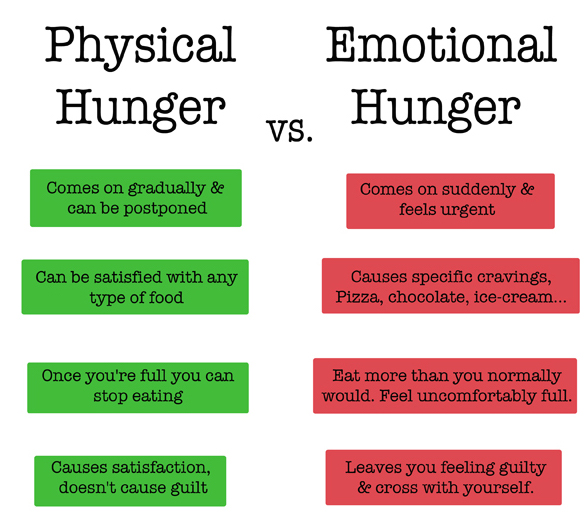
This article is written in partnership with Noom—they’re dedicated to making healthy living easier for us all, and we’re honored to work with them. ~ ed.
“When I am in trouble, eating is the only thing that consoles me. Indeed, when I am in really great trouble, as anyone who knows me intimately will tell you, I refuse everything except food and drink. At the present moment I am eating muffins because I am unhappy. Besides, I am particularly fond of muffins.” ~ Oscar Wilde
Food is comforting; it nourishes more than just our bodies.
We associate food with memories and feelings: warm soup on a cold day or when we’re sick in bed, birthday cake, our grandmother’s lasagna.
It’s easy to see how naturally our emotions and the food we eat can become entangled, and there’s nothing inherently wrong with that.
But when eating becomes a reward or a way of self-soothing, the relationship can turn toxic.
This is when eating becomes emotional eating, and it can be hard to control, or even to recognize that we’re doing it in the first place.
Emotional eating isn’t something to feel bad or ashamed of, but it is something to become mindful of. If we are eating to fill a void, it can take a serious toll on our body and, if prolonged, can lead to unhealthy weight gain, high blood pressure, anxiety, and many other health issues.
Using food to soothe ourselves also allows us to avoid the true emotion we’re feeling, which is an unhealthy habit that only serves to increase our suffering, from a Buddhist perspective.
“The most fundamental aggression to ourselves, the most fundamental harm we can do to ourselves, is to remain ignorant by not having the courage and the respect to look at ourselves honestly and gently.” ~ Pema Chödrön
Learning to Recognise the Difference between Emotional & Physical Hunger
Take this 30-second psychology-based health evaluation >>
In order to stop eating our emotions, we need to learn to recognize when it’s happening which involves paying attention to how we’re feeling: sad, depressed, anxious, bored, stressed? If we find ourselves heading to the fridge when we’re feeling any of these things, the chances are we’re not really hungry.
The next time you find yourself uncontrollably eating without feeling hungry or at the bottom of a box of crackers, check in with your emotions. Then find other ways to honor those emotions: taking a walk, writing in a journal, or practicing meditation are all healthier ways to feel our feelings and process them.
Mindful Eating: the Closest Thing to a Cure for Emotional Eating
“Don’t chew your worries, your fear, or your anger. If you chew your planning and your anxiety, it’s difficult to feel grateful for each piece of food. Just chew your food.” ~ Thich Nhat Hanh
Mindful eating is simply being aware of what we’re eating, and paying attention to the actual sensations we experience while we eat, without distraction. This practice helps us to slow down and really enjoy our food, which in turn helps us become more attuned to when and how much we really need to eat.
One of the reasons we, at Elephant, love Noom is their focus on mindful eating and its emotional, physical, and mental benefits. They make it their mission to teach us not how to eat less, or deprive ourselves of the foods we love and that nourish us on a soul-level (you know I’m talking to you, chocolate brownies), but how to eat more mindfully.
Train your mind for healthier habits, with Noom >>
To get a little taste of their approach, here’s an exercise from Noom’s writer on all things mindful and healthful eating, Anna Frinzi, to guide you through the process step by step, or rather, bite by bite:
Grab a food you thoroughly enjoy that you can hold in your hand-ideally one that you know is good for your health, and let’s begin!
Start off by sitting in a comfortable and alert position with your eyes open. Take a moment to first monitor your hunger. On a scale of 1-7, with 7 being uncomfortably full and 1 being horribly hangry, how hungry are you in this moment? Are you choosing to eat because of physical hunger or emotional hunger? Take a look at this graphic to help you evaluate where your hunger lies:

Stop dieting. Get life-long results. Start here >>
After noting your hunger, take a deep breath, the deepest one you have all day, removing the air from your lungs. Take three more intentional deep breaths as you let go of the tension in your body. Now, place the food in front of you and focus on it as we begin the process of eating mindfully. We will now guide you through a mindful eating journey with each of your five senses.
See: Take a close look at the food you chose. Become aware of its color and notice the space it takes up. How does your meal look? Observe the shape of the food. Where did it come from and what journey did it take to get to you?
Feel: Now, pick up the food lightly. Touch the surface. What words describe your food? Is it prickly or smooth, sticky, round or oval, soft or hard?
Smell: Hold the food up to your nose and notice the odor. How does what it smells like make you feel about putting it in your mouth?
Taste: Take a taste of the food. Chew it slowly and mindfully as you observe the texture, flavor, and all the other sensations that are occurring. Is it sour, bitter, sweet, or salty? Pay attention to your mouth salivating. After fully experiencing the food, swallow it and detect the movement of the food going down your esophagus as it goes down toward your stomach.
Hear: As the food travels down your body, pay attention to any noises that may occur. Pause for a moment and then take another slow, small taste. Listen to the sound of your teeth biting into the food.
How satisfying is each bite? Do you enjoy the taste? Pause and take a breath between bites to investigate your hunger and fullness. Pay attention to how your stomach feels and if you desire an additional piece. Listen to what your body is telling you.
How did that mindful eating meditation feel for you? It might have felt a bit uncomfortable or awkward, and it will take time to develop a realistic practice that works for you. The more you practice mindful eating, the easier it becomes. Next time you eat, take a moment to reflect on why you are choosing this particular food before you take your next bite.
To practice tapping into your hunger and fullness cues, and understanding how your cues impact your food choices, download Noom’s Mindful Eating worksheet.
If you’re looking to eat more mindfully and develop a healthier relationship with food, start your 2-week trial with Noom today.
 Share on bsky
Share on bsky

Read 1 comment and reply